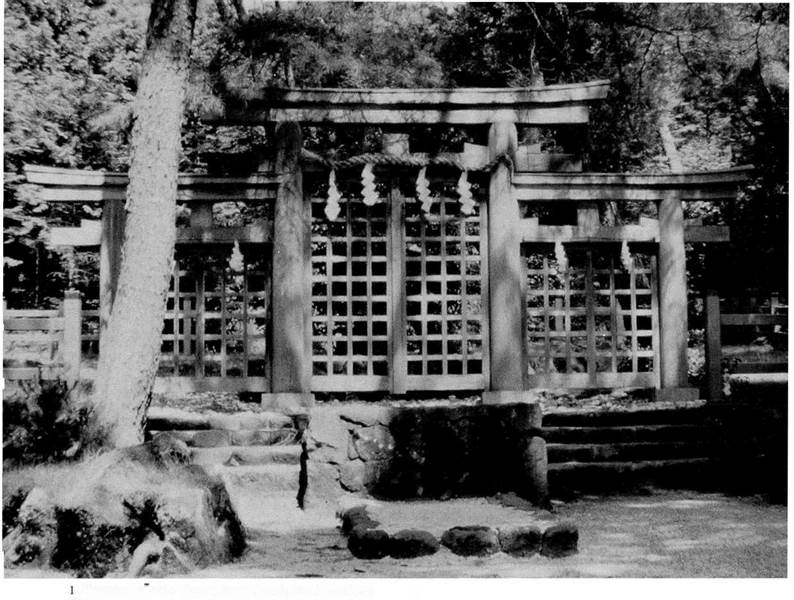|
M |
ount Miwa in Yamato (present-day Nara Prefecture) is a sacred mountain, thought to be manifested spirit according to the indigenous animistic religious beliefs of Shinto. Pre-Nara-period Shinto (pre-645) focused on nature worship in sacred sites—roped-off clearings surrounding unusually-shaped mountains, trees, rocks, waterfalls and other natural phenomena. The present Omiwa Shrine at the base of Mount Miwa consists of only a torii gate marking the entrance to the sacred grounds and a haiden, or worship hall, reminiscent of the early Shinto sites which lacked an architectural structure to enshrine каті, or spirit (Figure 1).
Mount Miwa is covered with primeval forest, revered and untouched from protohistoric times. Roped-off areas of old cryptomeria trees and clusters of rocks designated as himorogi and iwakura respectively—trees and rocks inhabited by divine spirit—have the appearance of playgrounds or “gardens” for каті. These iwakura megaliths, whether left untouched as nature set them or artificially clustered to create ritual spaces, cannot really be called gardens, but their playful grouping is in close accord with the guidelines for “setting stones” in Sakuteiki (Notes on garden making), the earliest known written document on Japanese garden making:
In the work of stone arrangement, you should first complete the placing of the principal stone having a distinct character, and then proceed to set other stones complying with the “requesting” mood of the principal stone…
The stones placed at the foot of the hill or in the hillside plain should resemble a pack of dogs crouching on the ground, or a running and scattering group of pigs, or else a calf playing nearby the seated mother cow.
In general, for one or two “running away” stones there should be placed seven or eight “chasing” stones. Stones thus placed may resemble, for example, children playing tag.1
The arrangement of rocks on sacred Mount Miwa is not, of course, the rock composition of a garden. However, with the gradual rearrangement of natural clusters of stones, the ancestral form of the Japanese garden began to emerge (Figures 2.1-2.3). This concept of natural order had developed more than four hundred years before it was expressed in the mid-eleventh-century Sakuteiki as “… set [ting] other stones complying with the ‘requesting’ mood of the principal stone.” Among the unique characteristics of
|
 Japanese gardens, which this book will attempt to define, this concept forms the foundation of and is seminally linked to the historic development of garden making in Japan through the present day.
Japanese gardens, which this book will attempt to define, this concept forms the foundation of and is seminally linked to the historic development of garden making in Japan through the present day.
Attributed to Tachibana no Toshitsuna (a. d. 1028— 1094), a Heian-period aristocrat accomplished in landscape garden design, Sakuteiki has long been regarded as a classic on the art of garden making. It is cited in virtually all studies of Japanese gardens written in Japan or abroad, and is itself the subject of numerous scholarly works. It is described in the introduction of one such book, by twentieth-century garden historian Tamura Tsuyoshi, as “… contain [ing] profoundly significant material, even when read today, regarding the basic structural techniques of Japanese gardens. One might even say it reveals the mysteries of the art of garden making.”
Sakuteiki was written at the height of the first phase of refinement in the developmental process of the Japanese garden. Tamura describes this historical phase:
There is no doubt that Japanese gardens broke away stylistically from Chinese gardens. From the late Nara period (a. d. 710-794) through the early Heian period (794-898) that which needed to be learned from Chinese gardens was ingested, and its nutritive value fully absorbed. In the late Heian period (898- 1185) this was successfully developed into the Japanese garden.2
The assimilation phase in the process of adopting and then assimilating foreign elements, often cited as a basic factor in the formation of Japanese gardens, is documented in Sakuteiki. Most books fail to deal with the question of just what was acquired from the palaces and gardens created for China’s vast open spaces and climate, which differ completely from the conditions in Japan. Neither do they describe in any detail how these imported forms were absorbed and transformed into the Japanese garden.
This chapter will examine the images inherited from

the Chinese cities, palaces, and gardens that gave rise to conceptual prototypes, as well as the relationship between the palatial buildings and gardens designed for a totally different space and climate—the interpretation at the ancient capital of Heian-kyo (present-day Kyoto).
Between the years a. d. 630 and 838, Japanese envoys made a total of fifteen trips to the Tang dynasty (a. d. 618-907) capital of Changan (present-day Xian). Each mission comprised 250 to 600 monks and aristocrats traveling on two to four ships. From the vast accumulation of information brought back by these envoys in the form of books, plans, paintings, and sundry documents, a capital was first constructed at Heijo-kyo (present-day Nara) on the model of
Changan; it was later reconstructed at Heian-kyo.
An idealized configuration of the Chinese cities, palaces, and gardens was distilled into a design formula; thus an “ideal” original forms the prototype. Unlike a real, physical form, a conceptual prototype is not subject to scale. This prototype implemented in the context of Japanese spatial and climatic conditions gave rise to a variety of simplified interpretations. These interpretations are in no way a rejection of the formula, since in essence they adhere to the formula’s framework, which is in part responsible for the tremendous degree of variety. Examination of these interpretations should make it possible to identify any uniquely Japanese methods of expression.



